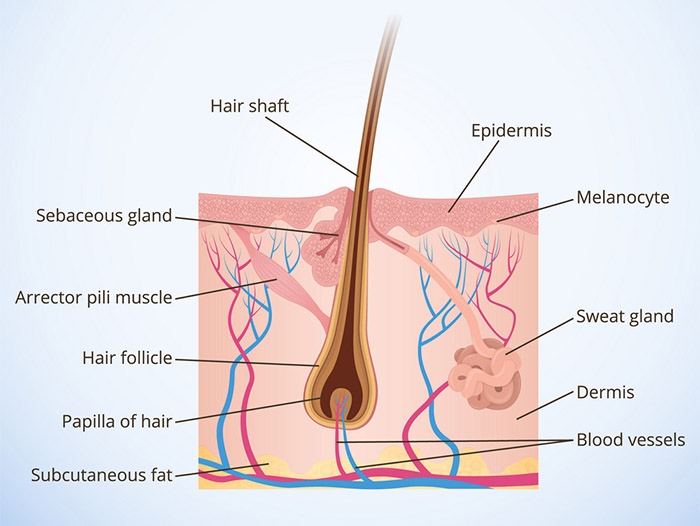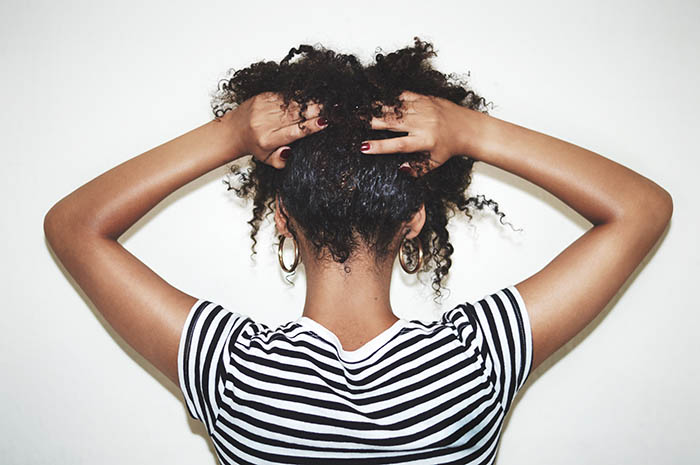Everybody has a lot of hair on their body either completely grown out or barely visible. Some people have blond and curly hair. However, others have brown, straight hair and older people mainly have grey hair or no hair at all on their heads. On average, people have between 75,000 and 150,000 hairs on their heads. But we even have a total amount of about 5,000,000 hairs on the whole body. This is an impressive number. In fact, in the course of a lifetime, hair can change in shape, appearance and colour. But why do we even have hair, why does hair differ from other people and why do only men have a beard? I will now answer these interesting questions. Everything you should know about hair.
Basically, the hair on our heads and bodies are the remains of our ancestors. In contrast to us, they even had a lot of dense hair. It resembles fur we know from many mammals. The reason for that is they needed it to protect themselves from cold and solar radiation. Due to further development in regions of Africa. These have declined considerably, as they don’t have a high function because of the hot climate there anymore.
We are covered with small hairs almost everywhere on our body. Exceptions are some parts of our body like the palms of the hands, soles of the feet and lips. Of course, in our modern age hair is no longer as magnificent as it was once. Nevertheless, they still have some important function for us:
If we didn’t have hair on our heads, we wouldn’t be protected on our scalps against cold and sunbeams. Hair absorbs UV radiation as well as infrared light. We are better protected from them because of our hair.
Body hair also functions as a stimulus enhancer. Our body hair transmits stimuli to the skin by touch. The stimuli are amplified.
Our hair on the armpits also has an important function. They have many sweat glands. This is why hairs operate as temperature regulators. This means sweat can be better drained.
Hair also has the function of regulating moisture. Our skin is surrounded by many sweat glands. Hair can absorb moisture.
Just as fingers and toenails are made of horny skin, hair is also equipped with a horn substance called “creatine”. The horn substance doesn’t have any tactile sensations. This is the reason it doesn’t hurt when someone cuts off your hair. It can only hurt if you injure your scalp where your hair is anchored e.g. by pulling. Substances responsible for building hair are carbon (50 %), oxygen (23 %), nitrogen (17 %), hydrogen (6 %) and sulphur (4 %). Usually, our hair has a water content of about 10%.
Our hair grows under our skin, to be even more precise out of a hair follicle. It is a tube-like invagination in our skin. At the end of the follicle is the hair root. The hair root is surrounded by connective tissue. This is called the hair papilla. The cells divide and grow upwards at the hair papilla. Once at the top, they become keratinized and form the hair shaft. Each hair also has a muscle that enables the hair to stand up. Therefore, especially when we are cold, we get goose bumps (hair straightens up).
Hair can grow quite long. Every day our hair grows 0.4 millimetres. This corresponds roughly to 15 centimetres in one year.
There are various types of hair, whether straight, curly or wavy. Basically, they just have a different cross-section. It depends largely on the shape of the hair. Straight hair is shaped with a round cross-section of the hair. It is a bit different with curly hair. The hair has a round cross-section. With curly hair, the cross-section is oval. There are also cultural differences. In some regions of the world, certain cross-sections are quite common. For example, the hair of East Asians has a round cross-section. Therefore, these hairs are particularly smooth. However, the European type is different. This type often has a round to oval cross-section. This is the reason why the hair is more straight or curly there. The cross-section of the hair in African regions usually has a strongly elliptical cross-section. Consequently, the hair there tends to form very strong and small curls.
The respective shapes are determined by your genetic information. If both parents of you have blond hair, you will likely have blond hair as well. The colour of your hair is determined near the hair root. There is a sebaceous gland. The sebaceous gland produces the pigment “melanin”. However, melanin has two components. They are called “eumelanin” and “pheomelanin” and contribute to the type of hair tone you get. Eumelanin determines the dark hair tones brown to black. On the other hand, Phaeomelanin matters in the hair tones blond to red. However, these two types of melanin can also mix, resulting in intermediate shades such as reddish brown. But some people don’t have melanin at all. This is called and known as albinism. Therefore, the hair is white to light blond.
Melanin also determines how much hair you get on your head. Growth rate and hair diameter as well as the number of hairs are genetic factors. It can be different from person to person. The number of hairs with people with blond hair is about 150,000. It is even almost half less with red-haired people. They have about 75000 hairs on their scalp. Melanin is not only responsible for the colour of the hair. It also determines the colour of the eyes and skin.
However, in old age the melanin situation is different. At a young age, the body still diligently produces the pigment melanin. In old age, the production of melanin decreases more and more. As a result, the hair loses its colour. They become colourless. Instead of the hair colour, more and more air bubbles are deposited in the hair. The reason why the hair appears grey is because of air bubbles. When the hair is illuminated with light, the person’s hair shimmers grey.
However, it doesn’t mean that you will immediately get grey hair when you get a little older. When it happens it is decided by your genes. We get new hair almost every four years. That’s how long it takes for our head hair to renew itself. They die and fall out. New hair then grows from the hair root. Especially for men it can happen quite easily that after a certain point of age no new hair grows back. They themselves are not to blame for this, but the so-called sex hormone “androgens” influences it. This hormone ensures that no more hair grows back after a certain age. This can even happen at a young age in some people. This predisposition is also caused by your own genes. If your father and grandfather also have hair loss, there is a high probability that it will happen to you in the same way as well.
But men are not the only ones who have androgens. Women are also supplied with it. However, it is present in smaller quantities in women. With age, the hormone balance also changes for women which also influences women’s hair. They also get thinner hair with age. Nevertheless, baldness is very rare for women.
In your childhood, your head hair is formed as terminal hair. It is different with our body hair. Initially, it consists mainly of the so-called vellus hair.
For women hair growth in the armpits and pubic area during puberty. In certain places on the body, the vellus hair develops into terminal hair. Again, our sex hormones influence it. These are released more frequently, especially during puberty. From then on, hair also starts growing on the face. The chest and shoulders are increasingly affected by hair growth as well. But this depends on the genetics of the individual.

-by Niels.H-
Sources:
https://en.wikipedia.org/wiki/Hair
https://www.britannica.com/science/hair-anatomy
https://www.helles-koepfchen.de/artikel/3084.html
https://www.vectorstock.com/royalty-free-vector/structure-hair-vector-14272966

